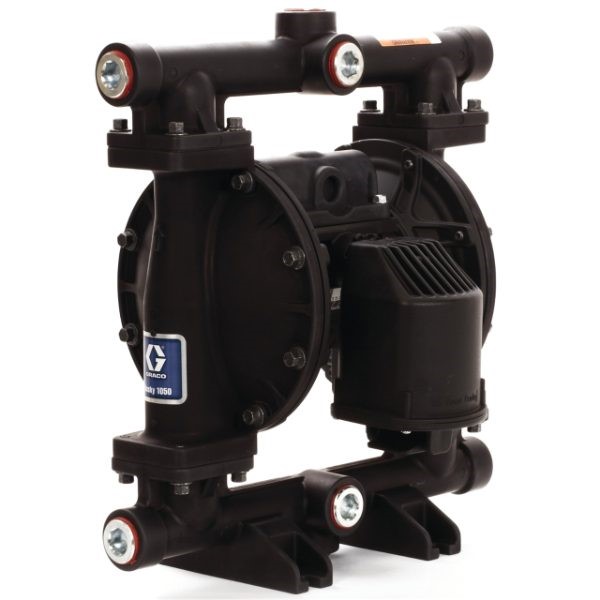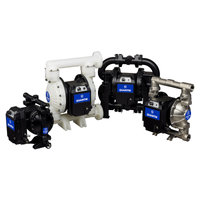How does a diaphragm pump work and what is it used for?
Understand the working principle of a diaphragm pump, the different types of diaphragm pumps, and the common uses and applications.
What is a diaphragm pump?
A diaphragm pump, also known as a membrane pump, is a type of positive displacement pump widely used in various industries due to its versatility and efficient pumping operation. In general, diaphragm pumps are used for fluid transfer and lower pressure spray applications that require a smooth and consistent flow. This makes them great options for food and beverage manufacturing, water treatment and transfer, chemical processing, paint transfer, and more.
There are two main types of diaphragm pumps, each with its own advantages and disadvantages: air-operated diaphragm pumps and electric diaphragm pumps. Choosing the right diaphragm pump depends on a variety of considerations, such as the fluid being pumped, flow rate requirements, pressure capabilities, and environmental conditions.
Types of diaphragm pumps
What is an air-operated diaphragm pump?
Air operated diaphragm pumps (also known as pneumatic pumps or AODD pumps) are powered by compressed air, which can make them ideal for remote or hazardous locations where operating with electricity is not always an option. Since pneumatic pumps do not need electricity to operate, they are less likely to generate sparks, which could be a concern in some hazardous environments. The biggest downside to air operated diaphragm pumps is the amount of energy they use, which can be very costly over the life of the pump.
What is an electric diaphragm pump?
Electric diaphragm pumps (or EODD pumps) use electricity as the power source to create a reciprocating action that moves fluid. It combines the reliability and fluid compatibility of a standard air operated diaphragm pump with the convenience and energy efficiency of an electric power source. Since they are powered by an electric motor, energy consumption can be reduced by up to 5x compared to air operated diaphragm pumps. Electric diaphragm pumps are also easy to install and operate without the need for specialised training, while offering precise control over flow rate and pressure.
How does a diaphragm pump work?
A diaphragm pump (both air and electric operated) relies on diaphragms which are flexible membranes that swing back and forth to move fluid through the pump and out to the discharge point. The difference between the two types of diaphragm pumps is how this movement takes place. While air-operated diaphragm pumps use air pressure to shift the diaphragm from one side to the other, electric diaphragm pumps accomplish this with its electric motor.
Diaphragm pump uses and applications
As discussed, diaphragm pumps are common choices for numerous applications due to their ability to handle many different types of fluids. Some of the most common industries include:
- Automotive: paint transfer and waste disposal
- Ceramics: slip/slurry transfer and wastewater transfer
- Chemical processing: material transfer, acid transfer, and chemical pumping
- Food and beverage: food and beverage processing and ingredient transfer
- Printing, packaging, pulp and paper: ink/glue/solvent/adhesive transfer
- Water and wastewater: water treatment/transfer and wastewater management
- Paint manufacturing: Mixing, loading, unloading and transferring of acrylics, solvents, resins, pigments and additives between different stages of production
Choosing the right diaphragm pump
When it comes to choosing the right diaphragm pump, there are a few considerations to keep in mind depending on your specific needs.
1. Type of fluid: The first step is to determine the type of fluid you need to pump. Is it abrasive, corrosive, viscous, or contain any solid particles? For thicker fluids, a diaphragm pump with a larger port may be required.
2. Flow rate and pressure requirements: Determine the flow rate and discharge pressure required for your pumping application. Electric diaphragm pumps have precise control in these areas, which is needed for fluid handling that requires consistency.
3. Power source: Your available power source could decide the type of diaphragm pump you can use. If access to a reliable electricity source is a concern, air operated diaphragm pumps might be the better option. Otherwise electric diaphragm pumps are ideal, especially for indoor environments where noise levels are a common issue, since electric pumps offer much quieter operation.
4. Maintenance and costs: Air operated diaphragm pumps typically have higher maintenance costs due to the number of moving parts, but can have a lower initial purchase price compared to electric diaphragm pumps. However, since electric diaphragm pumps require less energy, the total cost of ownership is considerably lower over the pump life. In fact, Graco offers an electric diaphragm pump that can reduce energy usage and costs by up to 80% of a traditional air operated diaphragm pump.
| Features | Graco electric diaphragm pumps | Other electric diaphragm pumps | Air-operated double diaphragm pumps | Peristaltic pumps | Progressive cavity pumps | Rotary lobe pumps |
|---|---|---|---|---|---|---|
| Stalls under pressure | X | X | ||||
| Runs dry | X | X | X | X | ||
| Self priming | X | X | X | X | X | |
| Metering capabilities | X | X | X | |||
| Energy efficient electric drive | X | X | X | X | X | |
| No rotational shaft seal | X | X | X | X | ||
| Low pulsation operation mode | X | X | X |
ROI calculator
Interested in going electric?
Answering three easy questions, calculate how much you could save by converting your facility to Graco electric double-diapragm pumps.
1) What industry are you in?
Based on your industry, we can set some default system requirements, like pump size, flow rate, and fluid pressure. Have you got a highly customised setup? Try our Advanced configurator.
2) How many pumps do you have?
We will estimate your savings based on the number and energy consumption of the pumps you already own.
3) What are your energy costs?
We will estimate your energy savings based on the average energy prices in your area.
Annual operational savings:
Check out our Advanced ROI calculator to learn how we calculated your savings.
Start again

Related articles
Electric diaphragm (EODD) pumps vs other technologies: pros and cons
There are many different types of industrial pumps, including diaphragm pumps, gear pumps, peristaltic pumps, and more. See an overview of each.
Electric oil pumps lead the way to improve energy efficiency and sustainability goals
Electric pumps lead the way to energy efficiency and sustainability goals
Electric pumps cut costs
Pumping systems are an essential part of manufacturing operations, many of which are powered by compressed air and consume large amounts of energy. As companies seek to build electrification strategies, QUANTM pumps provide a solution to replace inefficient technologies with a more sustainable trans...




